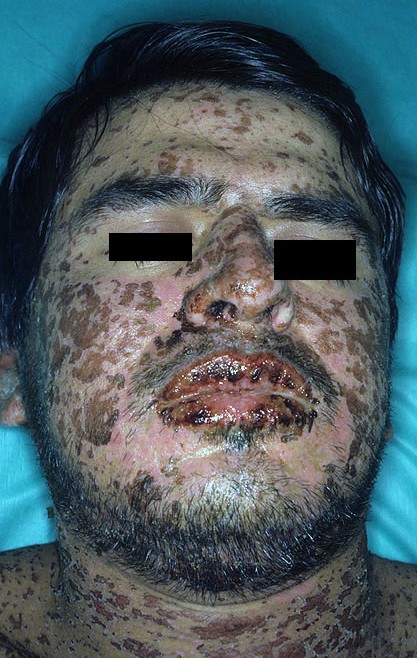Page Contents
OVERVIEW
This page is dedicated to organizing various examples of standardized exam questions whose topic is Stevens-Johnson Syndrome (SJS). While this may seem a odd practice, it is useful to see multiple examples of how SJS will be characterized on standardized exams (namely the boards and the shelf exams). This page is not meant to be used as a traditional question bank (as all of the answers will be the same), however seeing the classic “test” characterization for a topic is quite valuable.

KEY CHARACTERISTICS OF THIS CONDITION (ON EXAMS)
When it comes to standardized exams, each topic has its own “code” marked by key buzzwords, lab findings, clues, etc. If you are well versed in this code you will be able to more quickly identify the condition that is being discussed, and get the right answer on the exam you are taking. Below is the “code” for SJS.
Chief Complaints:
- Rash: new sudden onset
- Fever may also be present
Patient History:
- Usage of certain medications recently: phenytoin, carbamazepine, phenobarbital, lamotrigine, allopurinol, penicillin, sulfa drugs, erythromycin
Clinical Workup:
- Characteristic features on dermatological exam:
- Oral mucous involvement of rash
- Papules/vesicles/bullae present
- Sloughing off of skin
- Signs of skin necrosis
QUESTION EXAMPLES
Question # 1
Explanation # 1
Question # 2
Explanation # 2
TESTABLE FACTS ABOUT THIS TOPIC (BEYOND ITS IDENTIFICATION)
Many questions on standardized exams go beyond simply recognizing the underlying topic. Often there are specific testable facts regarding some aspect of the topic’s pathophysiology/management/clinical implications that are commonly asked. Some of these are listed below:
Cause:
- Immune mediated: Triggers a T-cell–mediated cytotoxic reaction to drug antigens in keratinocytes, causing the sloughing of skin creating vesicles and blisters.
- Medications that commonly cause it: phenytoin, carbamazepine, phenobarbital, lamotrigine, allopurinol, penicillin, sulfa drugs, erythromycin
Complications:
- Infections (superinfection): the most common cause of superimposed infections are S. aureus, P. aeruginosa, and Enterobacteriaceae organisms.
- Airway compromise: this can be caused by swelling in the airway. Patients may need to be intubated in order to protect their airway against closure.
Other:
- SJS vs. Toxic Epidermal Necrolysis (TEN): TEN covers >30% of your body while SJS is less than 10%
Page Updated: 03.27.2018